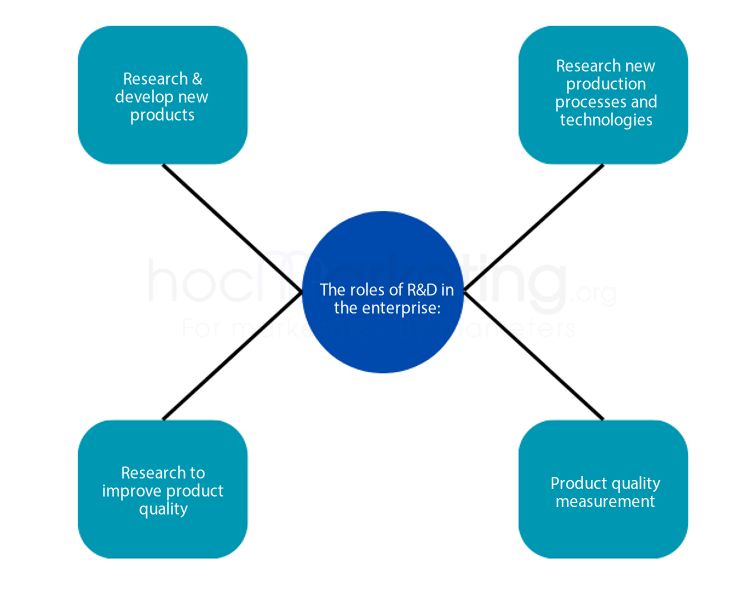
What is R&D? Job description of R&D department

What is R&D? Explain the concept of R&D. Analyze the role (duty/responsibility) of the R&D department in the enterprise. Job description of R&D department.
What is R&D?
R&D stands for Research and Development, often used to refer to the research and development activity or research and development department/department in a company or organization, with the goal of producing new products. new products, new technologies... to improve the competitiveness, productivity, revenue and profit of that company or organization.
The first R&D department appeared in 1980, at Edison General Electric company. That's right, you didn't get it wrong, this is the company of the inventor of the electric light bulb, Edison.
Today, R&D is present in almost all manufacturing companies, especially in the technology sector (manufacturing components, electronic equipment, computers, phones, transportation vehicles, software... )
The roles of R&D in the enterprise
R&D typically takes on the following roles within a business:
Research & develop new products
New product development has always been a common R&D role at most companies. New products included in the research will often inherit the advantages of the old products, overcome the disadvantages of the old products, as well as possess new features that the old products do not have, based on new technology.
Research new production processes and technologies
New production processes and technologies are also factors that are always present in the work plans of the R&D department. In general, production process & technology will directly affect the cost, resources and production efficiency of that business. Therefore, researching into a new process, new production technology that can help businesses save costs, resources, as well as increase production productivity is always necessary for any business.
Product quality measurement
It is possible for everyone to know that product quality is one of the ultimate weapons to help businesses compete, survive and develop in the market for a long time. However, it is important to accurately and comprehensively determine the quality of an enterprise's product (durability, stability, design, features, performance, experience, side effects...) and compare it. With the same quality products from other competitors is not easy. And the department in charge of this task is R&D.
Research to improve product quality
Some businesses dealing in products with a long life cycle such as food, Internet services, transportation... will always need the process of improving the quality of the products they are trading in order to maintain their viability. their competition in the market, as well as help businesses maintain a stable customer base. Therefore, the R&D department of these enterprises will need to research and identify the weaknesses that exist in the products of the enterprise, and how to overcome those disadvantages, as well as add additional features.
Importance of R&D in Business and Marketing
- R&D helps create a breakthrough in product quality, creating a competitive advantage that is hard to catch up by competitors.
- R&D helps to improve capacity, reduce production costs
R&D supports the implementation of Marketing research, providing extremely valuable information for Marketing through data analysis and processing. - R&D contributes to shaping long-term marketing strategies and plans through forecasts of new products and technologies.
Job description of R&D department
Their are major taskes which are usually assigned to R& department in a business:
Advice on new product ideas
New product ideas don't always come from the R&D department, but can come from any department or member of the business. However, the advisory role of R&D is very important because R&D will help businesses know whether the idea is feasible, how much it will cost, and how long it will take to get the first results.
Conduct new product development according to the proposed idea
After the enterprise has agreed on a new product idea, R&D will put this idea into the research and development process. Depending on product characteristics, environment and resources, the development process can be long or short. The R&D department will propose a cost (budget) for the research and provide timelines to mark the phases of this research.
Learn about new production technology
Technologies, equipment, tools, and software supporting production tend to innovate over time. Therefore, learning about new technologies is a common job in R&D departments. After the research process, R&D will filter out which new technologies are suitable and promising to export and apply to businesses.
Collect information
Collecting information is a very basic and common task in research. In some companies, research can be so dense and large-scale that there are R&D personnel with only one task: to collect information, through a variety of methods. Various methods such as search, survey, observation, interview, data acquisition, etc.
Information processing
Information processing is considered as one of the core jobs of the R&D department. The collected information will be synthesized and processed by various methods such as grouping, extracting, comparing, charting... to find answers to the research problems.
Experiment, test & measure
New products before being widely commercialized will often go through testing and measuring product quality. The R&D department will undertake tests by various methods, from internal testing, with specialized tools, to actual testing through selected customers...
Besides, before applying new production processes and technologies to replace old ones, they can also undergo tests conducted by the R&D department.








